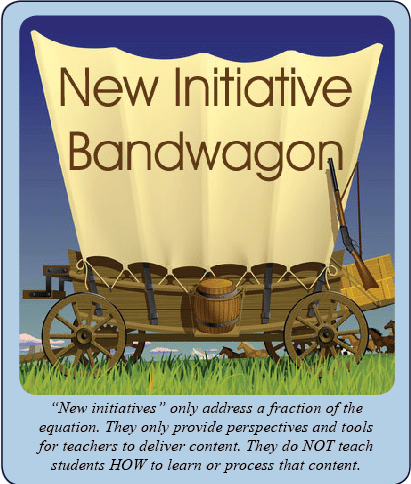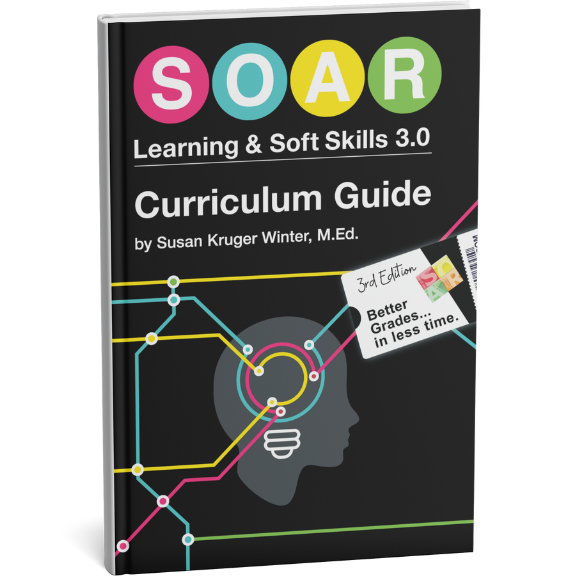How to Leverage Your Teacher’s Time and Abilities
If ONE of your teachers spends ONE minute in a ONE-hour class discussing lost, missing, or incomplete assignments with SIX students… 10% of class time is lost and everyone suffers!
Yet, this is an everyday occurrence.
Teachers tell me they are lucky if they can use 60% of their instructional time for instruction. I’ve spoken with hundreds of dedicated, hard-working teachers who are frustrated that their energies and efforts are squandered on back-tracking and nagging. Their stories all have a similar pattern…

Teachers are doing too much work in the classroom! It is time for STUDENTS to carry the burden of their own success! The best part is they WANT this responsibility; they thrive on a good challenge!
What It’s Like to Be a Classroom Teacher Today
Imagine the sensation of riding a bicycle on a warm, sunny day; you are coasting along with a gentle breeze blowing through your hair.
Suddenly, you are jarred from your enchanting daydreams as you begin to feel a drag.
You start pedaling harder. From what you can see, the road ahead appears flat, but your legs confirm that you are on an incline. You push harder and harder, but only go slower.
You are clearly fighting gravity.
Teachers feel this tension every single day. They are working harder and harder, but are clearly feeling a drag. You and your teachers are tasked with more things to do, document, and correlate every day.
Your extended efforts never seem to be enough as teachers begin to resist and students become more apathetic. You are stuck in the middle!
Many people are quick to blame technology, but that is not the root cause of the problem. In fact, if channeled correctly, technology can be a very empowering resource for students. There is something much more significant going on.
The “New Initiative” Bandwagon
In an effort to fix the problem, school districts and policy-makers usher in new “initiatives,” designed to improve instruction and “finally” make things better.
These initiatives are mapped together with new curriculum standards so that teachers can have “air-tight” plans when they enter the classroom.
The initiatives revolve in cycles, usually every 1-3 years. You sense that you are reinventing the wheel… and your teachers are pulling back. They are fatigued!
These initiatives are identified with various proper and common nouns. Some “classics” include Maslow’s Hierarchy and Bloom’s Taxonomy. More recent evolutions include VAK (visual, auditory, kinesthetic), 21st Century Skills, or Marzano’s Nine Essential Instructional Strategies.
Why These Initiatives Don’t Work
There is *nothing* wrong with any of these theories or strategies. I use most of them to create lessons and curriculum, myself.
At best, however, they only address 50% of the equation! They only provide perspectives and tools for the educator to deliver content.
They do not teach students how to process that content: how to consume it, analyze it, ask questions, or make decisions about it.
For Example…
Maslow tells us that our students need to have their basic needs met in order to be in the green zone of learning. This is important for teachers to know, but do we teach students how to deal with physical and emotional challenges that prevent them from reaching their optimal state of learning?
Bloom taught us to recognize different levels of learning. But, do we share these different levels with students…do they know how to shift into “high gear” learning?
Visual, Auditory, and Kinesthetic Learning Styles (VAK) are important for us, as educators, to understand so that we can provide instruction and assessments in a variety of modalities. However, VAK only confuses students; students can identify their preferred learning styles, but there is very little they can do about it because they have no control over the assignments and tests they are required to do.
The 21st Century Skills Framework is, well… confusing. The following is a description from the p21.org website:
The Framework presents a holistic view of 21st century teaching and learning that combines a discrete focus on 21st century student outcomes (a blending of specific skills, content knowledge, expertise and literacies) with innovative support systems to help students master the multi-dimensional abilities required of them in the 21st century.
I’M confused! How can this possibly empower students?
Marzano’s Nine Essential Instructional Strategies are filled with great strategies for teachers, such as encouraging teachers to use “nonlinguistic representations” (aka “symbols”) to represent relationships.
But students should be taught, explicitly, that visuals are powerful learning tools. They should then be coached through the process of making their own visuals, instead of always having visuals presented TO them.
Otherwise, they are simply memorizing meanings of symbols (low-gear learning) instead of creating their own associations (high-gear learning).
What Is Our Objective?
You and your teachers are swamped with strategies detailing what YOU should do, making all of you very overwhelmed. As you desperately try to juggle your curriculum, management, and discipline duties, it can be a challenge to keep your staff motivated under so many demands.
Is it any wonder?
Everything you’ve have been taught – every college class, PD session, and magazine article – suggests that teachers do all of the work. The very best, dedicated teachers internalize this pressure more than anyone, and they consistently feel ineffective…as if they are not doing enough.
In reality, teachers are doing too much work!
Meanwhile, students are only learning how to follow directions by memorizing visuals, filling in the blanks on graphic organizers, and answering questions instead of creating them.
The Other 50% of the Equation
You and your teachers will always feel as if you are slugging uphill… until your students are empowered to learn strategically. Study skills are the great differentiator because they are skills driven by students.
Study skills teach students how to learn; how to ask questions and navigate their way through learning with high-level skills.
To be fair, there are some things labeled as “study skills” that are not student-driven. However, study skills should be exclusively about empowering students how to: think forward and set their own goals, create their own purpose for learning, organize their papers and supplies, learn strategically, and monitor their progress along the way.
Notice that none of these skills are about teachers doing more work.
It is time for STUDENTS to carry the burden of their own success! The best part is they WANT this responsibility. They thrive on a good challenge! They would love to be woken from their educational coma.
Inspire Your Teachers!
The best way to leverage your teachers’ time and energies is to empower your students to be more effective learners! Students must learn how to develop their own questions and problem-solving abilities so that they can be prepared for the real-world situations of being an employee, entrepreneur, or family manager.
Release your teachers from the drag of pedaling and give your students a chance to feel the burn; they have been waiting for this opportunity, just click here to learn about our curriculum!
SK032715
Administrator Review Packet
Get a free digital review copy and information on the entire SOAR Curriculum
"*" indicates required fields
Get Our FREE Curriculum Guide!
The SOAR® Curriculum
The most critical learning, organizing, and communication skills needed for school. Learn more here.
Who’s Using SOAR®?
Click here to learn more.





